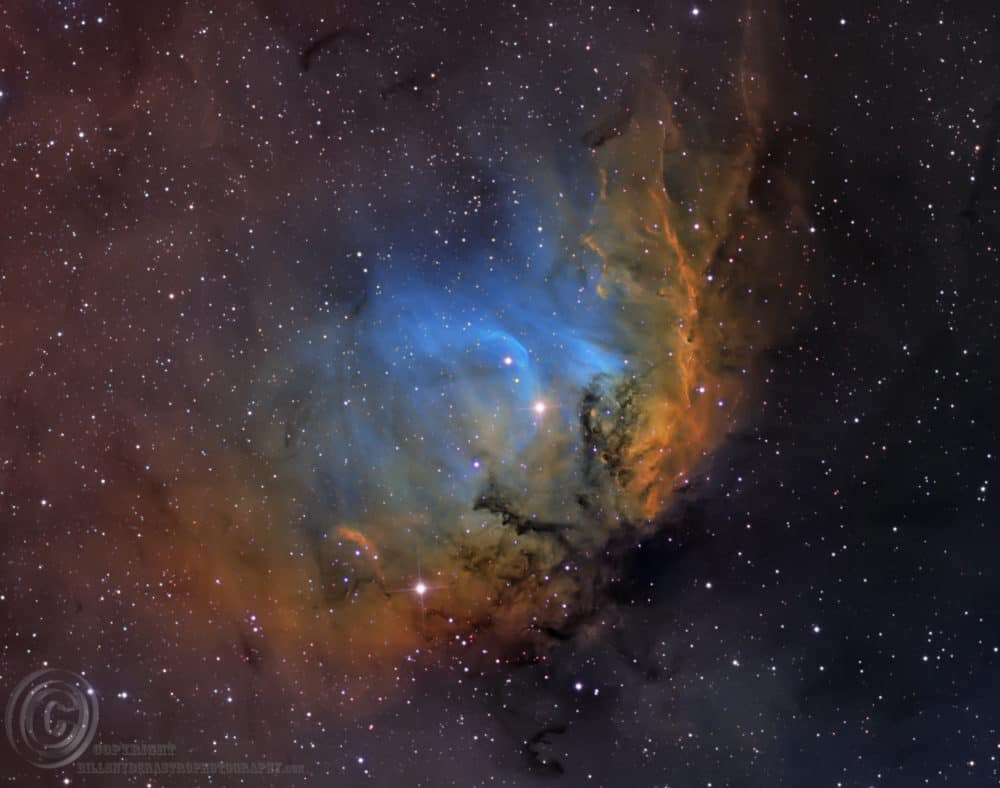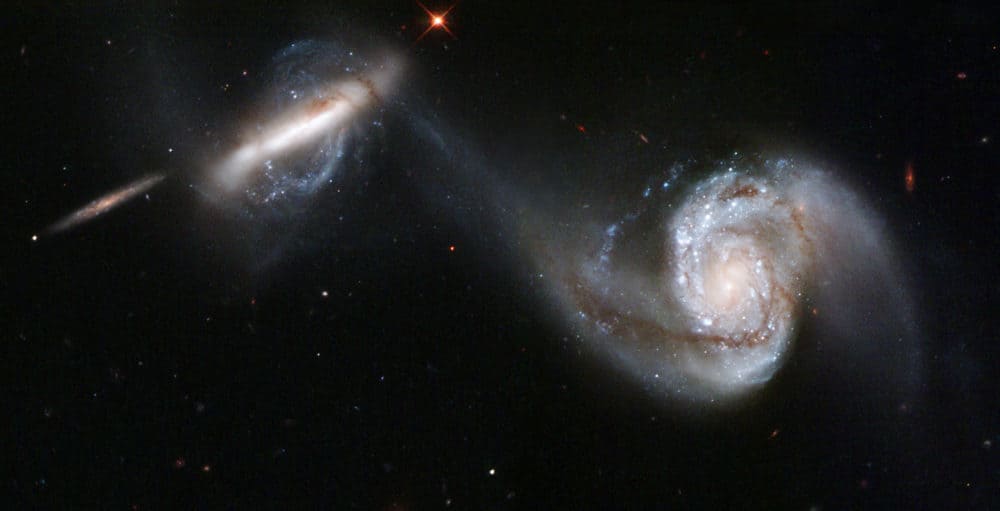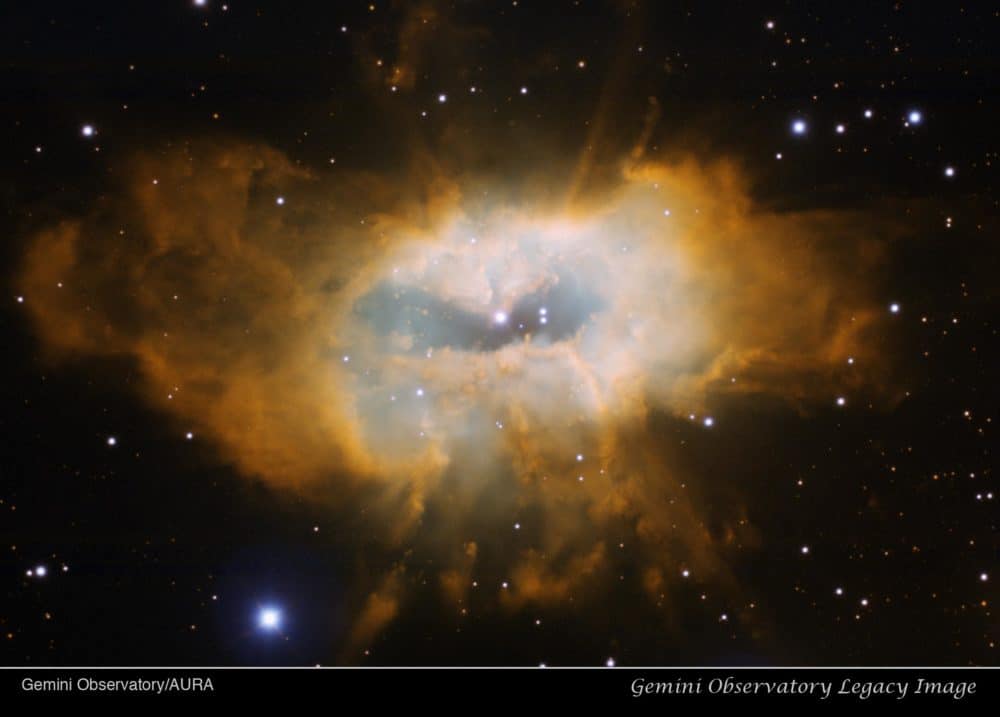Blog
Sharpless 101 (Sh2-101) is a H II region emission nebula located in the constellation Cygnus. It is sometimes also called the Tulip Nebulabecause it appears to resemble the outline of a tulip when imaged photographically. It was catalogued by astronomer Stewart Sharpless in his 1959 catalog of nebulae. It lies at a distance of about 6,000 light-years (5.7×1016 km; 3.5×1016 mi) from Earth.
Sh2-101, at least in the field seen from earth, is in close proximity to microquasar Cygnus X-1, site of one of the first suspected black holes.
more...
Anthony John Medeski (born June 28, 1965) is an American jazz keyboard player and composer. Medeski is a veteran of New York’s 1990s avant-garde jazz scene and is known popularly as a member of Medeski Martin & Wood.[1] He plays the acoustic piano and an eclectic array of keyboards, including the Hammond B3 organ, melodica, mellotron, clavinet, ARP String Ensemble, Wurlitzer electric piano, Moog Voyager Synthesizer, Wurlitzer 7300 Combo Organ, Vox Continental Baroque organ, and Yamaha CS-1 Synthesizer (a “kids’ toy”), among others. When playing acoustic piano, Medeski usually plays the Steinway piano and is listed as a Steinway Artist.
Medeski was born in Louisville, Kentucky, and grew up in Florida. After studying piano as a child (starting when he was five years old), he began as a teenager to perform with musicians such as Mark Murphy and Jaco Pastorius. He attended Pine Crest School. In 1983, after graduating from high school, he began studying piano at the New England Conservatory in Boston, where he performed as a sideman with Dewey Redman, Billy Higgins, Bob Mintzer, Alan Dawson. Medeski attributes his early interest in playing improvised music and jazz to listening to Oscar Peterson.
Medeski performs in a range of musical styles, from accessible groove based funk and jazz (such as the MMW albums and A Go Go with John Scofield) to more experimental music (including many of John Zorn‘s projects: Duras: Duchamp, Interzone, Liber Novus, Nova Express, Dreamachines, Templars: In Sacred Blood, At the Gates of Paradise etc. and collaborations with David Fiuczynski).
Medeski is best known for his work with Medeski Martin & Wood including drummer and percussionist Billy Martin and bassist Chris Wood. The trio formed in New York in 1991 playing gigs at The Village Gate. Since the mid-1990s they have toured steadily in both national and international funk, jazz, and jam music scenes. The band has collaborated with such musicians as Iggy Pop, Trey Anastasio and John Scofield.
Medeski produced and was featured on the Dirty Dozen Brass Band‘s 1999 release Buckjump. Also in 1999, he played the organ on two tracks of the Morphine album The Night.
In 2000, Medeski became a member of The Word, a bluesy gospel style project with members Robert Randolph (pedal steel) from Robert Randolph and the Family Band, brothers Luther Dickinson(guitar) and Cody Dickinson (drums), and Chris Chew (bass) of North Mississippi Allstars. The band released a self-titled album in 2001 and toured in 2001 and 2002. The band reunited in 2005 for a performance at the Bonnaroo Music Festival, and they embarked on tour again in late 2007.
He has also occasionally performed with Phil Lesh and Friends.
more...David “Honeyboy” Edwards (June 28, 1915 – August 29, 2011) was a Delta blues guitarist and singer from Mississippi. Edwards was born in Shaw, Mississippi. At the age of 14, he left home to travel with the bluesman Big Joe Williams, beginning life as an itinerant musician, which he maintained through the 1930s and 1940s. He performed with the famed blues musician Robert Johnson, with whom he developed a close friendship. Edwards was present on the night Johnson drank the poisoned whiskey that killed him, and his story has become the definitive version of Johnson’s demise. Edwards also knew and played with other leading bluesmen in the Mississippi Delta, including Charley Patton, Tommy Johnson, and Johnny Shines. He described the itinerant bluesman’s life: On Saturday, somebody like me or Robert Johnson would go into one of these little towns, play for nickels and dimes. And sometimes, you know, you could be playin’ and have such a big crowd that it would block the whole street. Then the police would come around, and then I’d go to another town and where I could play at. But most of the time, they would let you play. Then sometimes the man who owned a country store would give us something like a couple of dollars to play on a Saturday afternoon. We could hitchhike, transfer from truck to truck, or if we couldn’t catch one of them, we’d go to the train yard, ’cause the railroad was all through that part of the country then…we might hop a freight, go to St. Louis or Chicago. Or we might hear about where a job was paying off – a highway crew, a railroad job, a levee camp there along the river, or some place in the country where a lot of people were workin’ on a farm. You could go there and play and everybody would hand you some money. I didn’t have a special place then. Anywhere was home. Where I do good, I stay. When it gets bad and dull, I’m gone.
Flamenco Fridays featuring Rondeña.
A Rondeña is a palo or musical form of flamenco originating in the town of Ronda in the province of Málaga in Spain. In common with other palos originating in Málaga, the rondeña antedated flamenco proper and became incorporated into it during the 19th century. The rondeña has its origin in the fandango malagueño and it is said that it is “the oldest fandango actually known”. According to the experts, the name does not derive from “nocturnal rounds”, as some have suggested, but is based solely on the name of the town Ronda.
The rondeña spread enormously throughout Andalusia in the 19th century, to such an extent that numerous foreign observers, touring the region at the time, referred to it later in their writings.
The rondeña has evolved in recent times, with a decrease in melismatic ornamentation, and generally the tempo is somewhat slower than was previously the case. It is a composition with an ad lib time signature
( compás ), and the lyrics are frequently about rustic life. A verse consists of four octosyllabic lines which sometimes become five through repetition of the second line.
In dance, having had no time signature at one time, the rondeña displays a rhythm of wild abandon. Some dancers have used the rhythm of the taranto, which has many similarities but, being rondeña, more open and evocative.
more...Arp 87 (also known as NGC 3808) is a pair of two interacting galaxies, NGC 3808A and NGC 3808B. They are situated in the Leo constellation. NGC 3808A, the brighter, is a peculiar spiral galaxy, while NGC 3808B is an irregular galaxy.
The two galaxies were discovered on 10 April 1785 by William Herschel. The two are located about 330 million light-years (100 megaparsecs) away from the Earth. Arp 87 was observed by the Hubble Telescope in 2007, which revealed massive clouds of gas and dust flowing from one galaxy to another. Additionally, both galaxies appear to have been distorted.
more...
Sam Tshabalala is a South African singer and guitarist . June 27th 1955.
Singer and guitarist of the band The Malopoets, the first South African black musicians performing at the Market Theater in Johannesburg , he is considered a hero of cultural resistance to the apartheid regime then in place in his country.
For more than 20 years, he lives in France .
His music combines elements of the musical and choreographic traditions of black South African cultures with jazz , funk or reggaerhythms. His songs tell the often painful story of South Africa, the hopes of the people and the life in the townships , in many languages among which are Zulu , shangaan , tswana and English. The melodies of these songs are paradoxically sweet and joyful.
more...Rahul Dev Burman (27 June 1939 – 4 January 1994) was an Indian music director who is regarded as one of the most influential composers of the Indian film industry. From the 1960s to the 1990s, Burman composed musical scores for 331 films. Burman did major work with Asha Bhosle (his wife) and Kishore Kumar and scored many of the songs that made these singers famous. He has also scored many songs sung by Lata Mangeshkar. Nicknamed Pancham, he was the only son of the composer Sachin Dev Burman.
He was mainly active in the Hindi film industry as a composer, and also provided vocals for a few compositions. He served as an influence to the next generation of Indian music directors, and his songs continue to be popular in India and overseas.
Burman was born to the Bollywood composer/singer Sachin Dev Burman and his lyricist wife Meera Dev Burman (née Dasgupta), in Calcutta. Initially, he was nicknamed Tublu by his maternal grandmother, although he later became known by the nickname Pancham. According to some stories, he was nicknamed Pancham because, as a child, whenever he cried, it sounded in the fifth note (Pa), G scale, of music notation. The word Panchammeans five (or fifth) in Bengali, his mother tongue. Another theory says that the baby was nicknamed Pancham because he could cry in five different notes. Yet another version is that when the veteran Indian actor Ashok Kumar saw a newborn Rahul uttering the syllable Pa repeatedly, he nicknamed the boy Pancham.
more...George Braith (born George Timothy Braithwaite on June 26, 1939) is a soul-jazz saxophonist from New York.
Braith is known for playing multiple horns at once, a technique pioneered by Roland Kirk. Braith is credited with the invention of the Braithophone, two different horns (straight alto and soprano) mended together by extensions, valves and connections.
Braith is featured in a mosaic in the 72nd street station of the Second Avenue Subway in the New York City Subway system.
Of Braith’s album Musart Thom Jurek at AllMusic wrote, “Musart is his masterpiece; it is one of the most diverse yet refined albums to come out of the ’60s, and has few peers even today.”
more...St. Elmo Sylvester Hope (June 27, 1923 – May 19, 1967) was an American jazz pianist, composer, and arranger, chiefly in the bebop and hard bopgenres. He grew up playing and listening to jazz and classical music with Bud Powell, and both were close friends of another influential pianist, Thelonious Monk.
Hope survived being shot by police as a youth to become a New York-based musician who recorded with several emerging stars in the early to mid-1950s, including trumpeter Clifford Brown, and saxophonists John Coltrane, Lou Donaldson, Jackie McLean, and Sonny Rollins. A long-term heroin user, Hope had his license to perform in New York’s clubs withdrawn after a drug conviction, so he moved to Los Angeles in 1957. He was not happy during his four years on the West Coast, but had some successful collaborations there, including with saxophonist Harold Land.
More recordings as leader ensued following Hope’s return to New York, but they did little to gain him more public or critical attention. Further drug and health problems reduced the frequency of his public performances, which ended a year before his death, at the age of 43. He remains little known, despite, or because of, the individuality of his playing and composing, which were complex and stressed subtlety and variation rather than the virtuosity predominant in bebop.
Elmo Hope was born on June 27, 1923, in New York City. His parents, Simon and Gertrude Hope, were immigrants from the Caribbean, and had several children. Elmo began playing the piano aged seven. He had classical music lessons as a child, and won solo piano recital contests from 1938. Fellow pianist Bud Powell was a childhood friend; together, they played and listened to jazz and classical music. Hope attended Benjamin Franklin High School, which was known for its music program. He developed an excellent understanding of harmony, and composed jazz and classical pieces at school.
At the age of 17, Hope was shot by a New York policeman. He was taken to Sydenham Hospital, where doctors reported that the bullet had narrowly missed his spine. Six weeks later, after Hope had been released from the hospital, he appeared in court, charged with “assault, attempted robbery and violation of the Sullivan Law“. The police officers involved testified in court that Hope had been part of a group of five involved in a mugging. None of the other four, or any of the three alleged white victims, was identified by police; Hope stated that he had been running away with other passers by after police started shooting, and was hit while trying to enter a hallway. The judge freed Hope of all the charges, after which Hope’s attorney described the shooting as an “outrage”, and the charges as “an attempted frameup”.
more...The Serpens South star cluster is a relatively dense group of more than 600 young stars, dozens of which are protostars just beginning to form.The cluster is situated in the southern portion of the Serpens cloud (adjacent to the star-forming region known as W40). The stars are embedded in a dense filament of interstellar gas, which is part of the giant molecular cloud that has given rise to the cluster of young stars in W40. This entire complex is located at a distance of 1420 light-years (436 pc) from the Earth, and is approximately the same distance as the Serpens Main cluster.
The cluster was uncovered by NASA’s Spitzer Space Telescope. This discovery was made possible by the infrared capabilities of this space telescope, which were necessary because the stars are completely obscured by interstellar dust in the Serpens cloud at visible wavelengths. Hundreds of young stellar objects have been detected at mid-infrared objects using these data. X-ray observations by NASA’s Chandra X-ray Observatory have also provided detailed information about the stellar cluster. And, the region has served as a laboratory for radio-wavelength studies of star formation in dense molecular filaments.
The discovery of Serpens South is a direct result of the Gould’s Belt Legacy project at the Harvard-Smithsonian Center for Astrophysics, which aims to study all prominent star-forming regions within about 1,600 light-years of Earth. The Gould Belt is a ring of molecular clouds and associated star-forming regions first described by astronomer Benjamin Gould in 1879. Although the Serpens Molecular cloud is too distant to formally be considered a member of the Gould Belt, it is often included in Gould Belt surveys.
more...Nicole Saba (Arabic: نيكول سابا; born 26 June 1974 is a singer and actress from Lebanon.
From 1998-2001, Nicole Saba was a member of the Lebanese pop group The 4 Cats, She replaced “Roula Bahnam” who officially shot with the band in their first video “Ashra HdashEtnash”, Nicole released 2 albums with the 4Cats “Tic – Tick” and “Layl Nhar” and shot 4 video clips with them “Yanassini, Kan Ezaman, Layl Nhar and Maba2a Eida” and shot the band’s commercial for LUX Shower Gel. Then embarked on a solo singing as well as an acting career. Her debut album was released in 2004, and her first film came out in 2003. She has subsequently had success with additional roles in Egyptian-made films.
Nicole was given the award for the best singer in 2004 by Sayidaty magazine.
https://www.youtube.com/watch?v=n_40rID0Egk
more...Reginald “Reggie” Workman (born June 26, 1937 in Philadelphia, Pennsylvania) is an American avant-garde jazz and hard bop double bassist, recognized for his work with both John Coltrane and Art Blakey.
He is currently a professor at The New School for Jazz and Contemporary Music in New York City, and is a member of the group, Trio 3, with Oliver Lake and Andrew Cyrille.
Workman has been a resident of Montclair, New Jersey
https://www.youtube.com/watch?v=W3lDcLUnpJI
more...
Big Bill Broonzy (born Lee Conley Bradley, June 26, 1903 – August 14, 1958) was an American blues singer, songwriter and guitarist. His career began in the 1920s, when he played country blues to mostly African-American audiences. Through the 1930s and 1940s he successfully navigated a transition in style to a more urban blues sound popular with working-class African-American audiences. In the 1950s a return to his traditional folk-blues roots made him one of the leading figures of the emerging American folk music revival and an international star. His long and varied career marks him as one of the key figures in the development of blues music in the 20th century.
Broonzy copyrighted more than 300 songs during his lifetime, including both adaptations of traditional folk songs and original blues songs. As a blues composer, he was unique in writing songs that reflected his rural-to-urban experiences.
Born Lee Conley Bradley, he was one of the seventeen children of Frank Broonzy (Bradley) and Mittie Belcher. The date and place of his birth are disputed. Broonzy claimed to have been born in Scott, Mississippi, but a body of emerging research compiled by the blues historian Robert Reisman suggests that he was born in Jefferson County, Arkansas. Broonzy claimed he was born in 1893, and many sources report that year, but family records discovered after his death suggested that the year was 1903. Soon after his birth the family moved to an area near Pine Bluff, Arkansas, where Bill spent his youth. He began playing music at an early age. At the age of 10 he made himself a fiddle from a cigar box and learned how to play spirituals and folk songs from his uncle, Jerry Belcher. He and a friend, Louis Carter, who played a homemade guitar, began performing at social and church functions. These early performances included playing at “two-stages”: picnics where whites and blacks danced at the same event, but with different stages for blacks and whites.
more...Gemini Legacy image of the complex planetary nebula Sh2-71 as imaged by the Gemini Multi-Object Spectrograph on Gemini North on Mauna Kea in Hawai‘i. The long-assumed central star is the brightest star near the center, but some astronomers wonder if the much dimmer and bluer star (just to the right and down a bit) might be the parent of this beautiful object. The image is composed of three narrow-band images, and each is assigned a color as follows: H-alpha (orange), HeII (blue) and [OIII] (cyan). Each image is 15 minutes in duration, the field-of-view is 5.3 x 3.6 arcminutes, and the image is rotated 110 degrees clockwise from north up, east left.
Sh2-71 (Sharpless 71) is an unusual and complex planetary nebula located about 3,260 light-years away from Earth in the northern constellation of Aquila (the Eagle). It is embroiled in a bit of controversy over its “birth parents”.
Sh2-71 is the 71st object in a catalogue of nebulae originally assembled by the U.S. astronomer Stewart Sharpless of the US Naval Observatory in Flagstaff, Arizona. It is from his second catalogue, of 313 nebulae, published in 1959. (In fact there are more than 313 objects as subsequent research has shown that some of the Sharpless nebulae consist of more than one object.)
Planetary nebulae represent the final brief stage in the life of a medium-sized star like our Sun. While consuming the last of the fuel in its core, the dying star expels a large portion of its outer envelope. This material then becomes heated by the radiation from the stellar remnant and radiates, producing glowing clouds of gas. They are called “planetary” nebulae because early observers thought they looked like planets; but they don’t have anything to do with planets at all.
Astronomers long assumed that Sh2-71 formed from the death throes of the brightest star (a binary system) which lies very close to the center of the nebula’s gas shell. But new observations have shown that the nature of a dimmer, bluer star – just to the right, and a bit lower than the bright central star – might provide a better fit for the nebula’s “birth parent.”
The uncertainty arises from the fact that the brighter central star doesn’t appear to radiate enough high-energy (ultraviolet) light to cause the surrounding gas to glow as intensely as it does, whereas the dimmer, bluer star likely does. On the other hand, the brighter star’s binary nature would help explain the nebula’s asymmetrical structure. Astronomers do not yet known if the dimmer, bluer star also has a companion.
Another unresolved issue is whether the brighter star’s unseen companion might be hot enough to excite the gas to glow. If so, this pair might be able to hold on to its parental connection to the nebula.
However, at the assumed distance to the nebula, the faint star has about the right brightness to be the fading remnant of the nebula’s progenitor star. Then again, the brighter binary star is an uncommon one that shows strong and broad hydrogen-alpha emission, which are seen in some planetary nebulae.
more...More Posts
- Norah Jones
- Eric Clapton
- World Music Romeo Santos
- Daily Roots Augustus Pablo
- Temple Israel Erev Shabbat Service
- Cosmos NGC 520
- Michael Brecker
- Vangelis
- Astrud Gilberto
- Flamenco Fridays José Anillo, y Rafael Rodríguez
- Daily Roots Barrington Levy
- Celestial Antiquity CANCELLED
- Cosmos NGC 2077
- Gary Willis
- Tete Montoliu
- Thad Jones
- World Fusion Mixed World Ensemble
- Daily Roots Dennis Brown
- Cosmos Abell 1656
- Johnny Copeland



